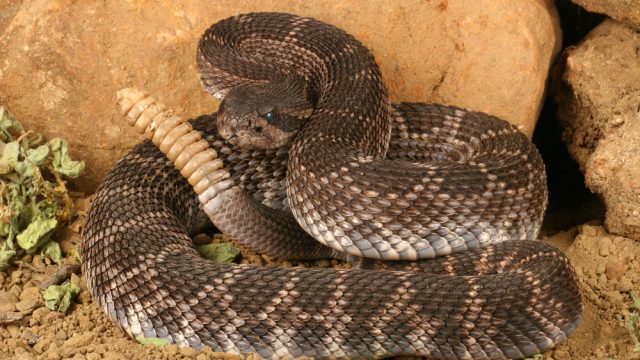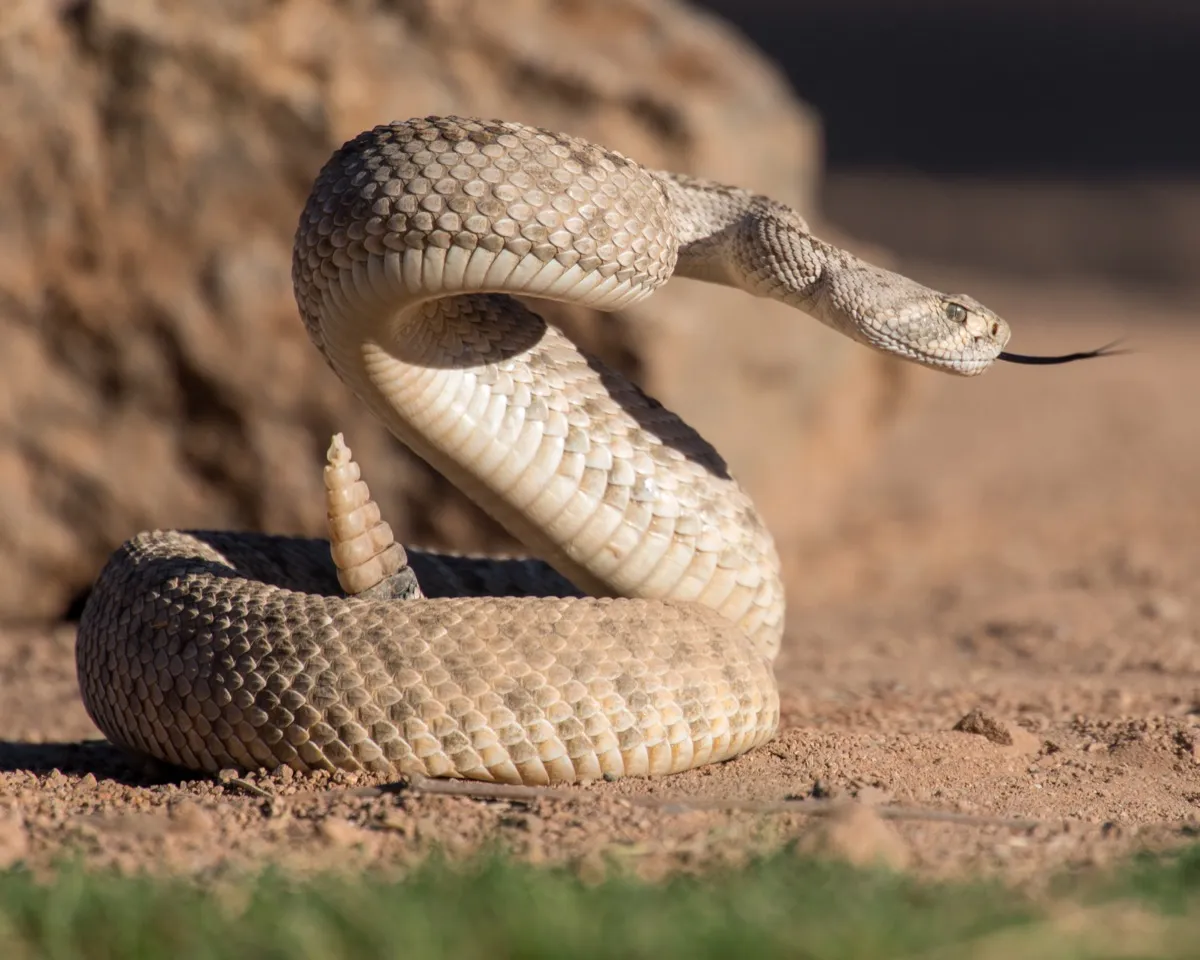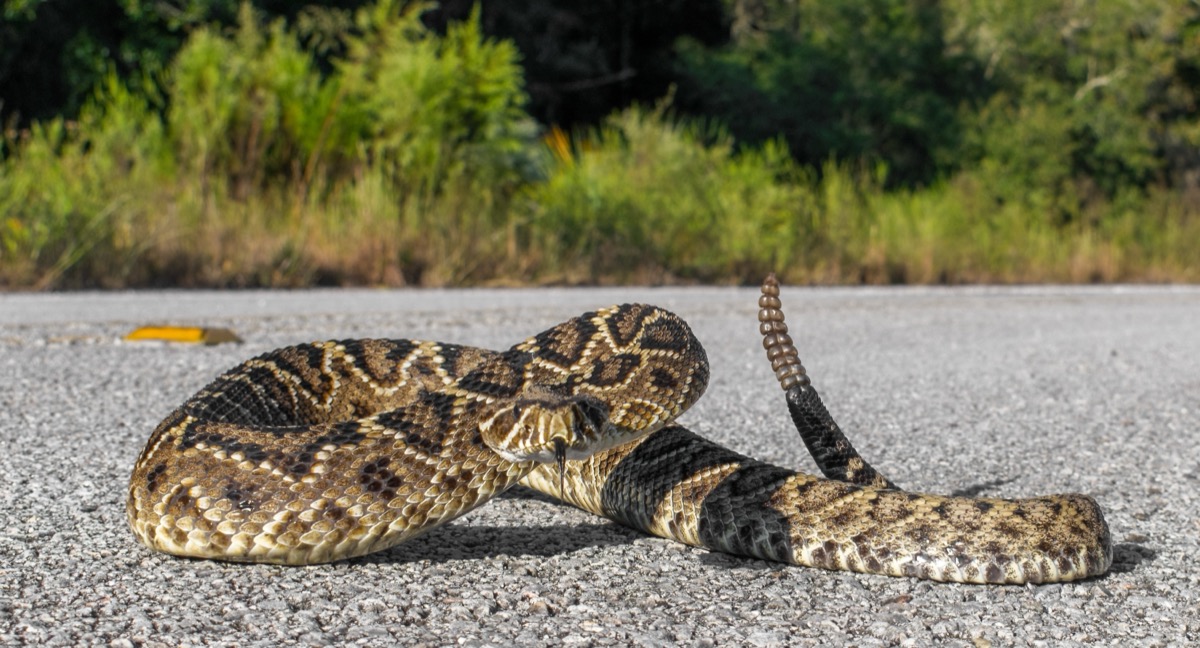You’re More Likely to See Rattlesnakes in Your Yard Right Now—Here’s Why

Your yard is the place where your hard gardening work can truly shine, summer get-togethers can happen, and you can enjoy a small slice of nature right at your doorstep. However, it’s also a part of the immediate surrounding natural environment and open to the animals that may live nearby—including snakes. Despite their unfortunate reputation, the reptiles should actually be seen as a massive benefit to your garden for their natural pest-controlling capabilities and will usually keep to themselves unless they’re accidentally disturbed. But now, experts are warning that it may be more likely to see rattlesnakes in your yard at the moment. Read on to see why the venomous reptiles are out in greater numbers these days.
READ THIS NEXT: The No. 1 Place Snakes Love to Hide in Your Home.
Rattlesnakes can be found across much of the U.S. but are more common in some areas.

Rattlesnakes are arguably among the most well-known venomous reptiles, thanks to the distinct warning sound that gives them their name. But their habitat also happens to be spread out quite wide across the continental U.S., spanning from the meadows of the Northeast to the swamps of the Southeast and even into higher elevations on mountains everywhere in between, according to LiveScience. However, they are most prevalent in the scrubby brush, deserts, and rocky hills of the Southwest.
Fortunately, their defining noise-making characteristic can make you less likely to be surprised by their presence and can easily let them be. As a result, most bites tend to result from accidental encounters when someone steps on a rattlesnake by mistake. But while all species of the reptile carry a relatively potent venom, it’s exceedingly rare for them to be fatal if they are treated quickly and appropriately, LiveScience reports.
And while you should always keep an eye out for the rattling reptiles while walking, hiking, or gardening, experts say there may be more than usual around lately.
Certain conditions have made it more likely you’ll see a rattlesnake in your yard right now.

Warm weather makes it more likely for people to spend time enjoying the outdoors. But the same temperature spike also makes it more likely for rattlesnakes to become increasingly active and make their way into your yard or property. This is especially likely in areas like California’s Central Coast, where the snakes are commonly found.
“Overall, the warm weather does tend to draw them out,” Tanya Luthin, a volunteer snake relocator with Central Coast Snake Services, told local NBC affiliate KSBY6 during an interview. “You’re probably more likely to see them in your yard in the warm season,” adding that she had been called out to multiple cities along the coast to retrieve and safely relocate the reptiles in recent days.
Other annual factors are also playing into the increased rattlesnake activity. “The females are having babies right now,” Emily Taylor, PhD, a professor of biological science at California Polytechnic State University, San Luis Obispo and owner of Central Coast Snake Services, told KSBY. “Birthing started in August. Meanwhile, it’s mating season for the females that are not pregnant this year. The males are looking for those females.”
RELATED: For more up-to-date information, sign up for our daily newsletter.
Studies have shown that temperatures can have an effect on rattlesnake activity.

In most areas, authorities consider the warmer months from March to October or November to be rattlesnake season. But unusually high temperatures can immediately affect the reptiles’ behavior. “Heat waves can bring out snakes,” Taylor told KSBY, explaining that her company typically sees an increase in calls coincide with increased temperatures. Currently, California is suffering through a record-breaking heat wave that has affected cities along the coast from Los Angeles up to the Bay Area.
But the Golden State is far from the only place that sees more rattlesnakes when things get hot. Research has shown that higher temperatures often correlate to an increase in snakebites overall.
“The potential for human/pet/snake encounters likely increases with increased snake and human activity during the summer months,” Samuel T. Smallidge, a wildlife extension specialist with New Mexico State University, wrote in an email to the Santa Fe New Mexican, citing a 2020 report from the Journal of Environmental and Public Health.
Here’s how you can avoid making your yard more attractive to rattlesnakes year-round.

Fortunately, professionals are well equipped to handle any situation in which an unexpected rattlesnake makes its way into your yard in a way that keeps both parties safe.
“We’re going to relocate it between a quarter mile and a half mile away,” Taylor told KSBY of her operation. “We are mandated and permitted by the California Department of Fish and Wildlife to relocate snakes those distances. They usually don’t come back, but they still do well, so it’s a win-win situation for the homeowners and for the snakes.”
Still, there are plenty of ways you can get proactive about keeping the reptiles out of your yard. “The key to making your yard unattractive to snakes is to eliminate what I call ‘low shade.’ This includes shade-providing structures, objects, and plants that are low to the ground and provide both shade and hiding spots for snakes,” Taylor previously wrote in a Medium post, explicitly citing “bushy plants like rosemary, lavender, or Lantana shrubs” as a notorious hiding spot for snakes.
“A yard that is unattractive to snakes—especially the venomous ones—has the following characteristics: the grass is kept mowed; plants chosen for landscaping are ‘spindly’ rather than bushy so that they cast little shade and you can easily see the base of the bush; firewood is stored on a table or other platform elevated a few feet above the ground, with no debris piles; and snakes cannot crawl underneath the buildings because they are flush with the ground or because access under porches or into crawl spaces is blocked off,” Taylor suggests.